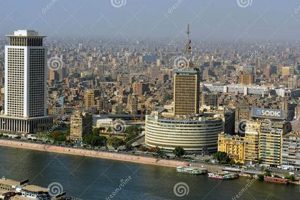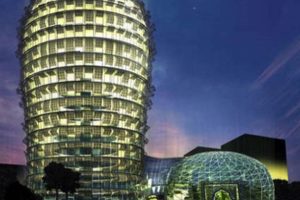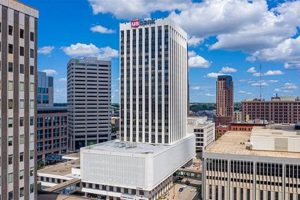A skyscraper is a continuously habitable high-rise building having multiple floors with office space or residential units, and standing more than 150 m (492 ft) tall, though there is no universally accepted height that qualifies a building as a skyscraper.
Skyscrapers are often used to house businesses, offices, and residential units, and are often constructed in densely populated areas where land is scarce. The first skyscraper was the Home Insurance Building in Chicago, which was completed in 1885 and stood 10 stories tall. Today, the tallest skyscraper in the world is the Burj Khalifa in Dubai, which stands 828 m (2,717 ft) tall.
Skyscrapers offer a number of benefits, including:
- Increased density: Skyscrapers can accommodate a large number of people in a small area, which can help to reduce traffic congestion and pollution.
- Energy efficiency: Skyscrapers can be designed to be energy efficient, using features such as natural ventilation and solar panels.
- Improved quality of life: Skyscrapers can provide residents with access to a variety of amenities, such as parks, restaurants, and shopping.
Skyscrapers are an important part of the modern cityscape, and they continue to be built in cities around the world.
1. Height
The height of a skyscraper is one of the most important factors in its definition. In order to be considered a skyscraper, a building must be at least 150 meters (492 feet) tall. This height requirement is important for a number of reasons.
First, the height of a skyscraper allows it to accommodate a large number of people and businesses. A single skyscraper can house thousands of workers and residents, which can help to reduce traffic congestion and pollution. Second, the height of a skyscraper allows it to take advantage of natural ventilation and solar energy. This can help to reduce the building’s energy consumption and operating costs. Third, the height of a skyscraper can make it a landmark and a symbol of a city’s economic and architectural prowess.
There are a number of real-life examples of how the height of a skyscraper can affect its function and significance. For example, the Burj Khalifa in Dubai is the tallest building in the world, standing at 828 meters (2,717 feet) tall. The Burj Khalifa is a mixed-use building that houses offices, apartments, and a hotel. The building’s height allows it to accommodate a large number of people and businesses, and it also provides stunning views of the city. Another example is the Empire State Building in New York City. The Empire State Building is 381 meters (1,250 feet) tall, and it is one of the most iconic buildings in the world. The building’s height makes it a landmark and a symbol of New York City’s economic and architectural prowess.
The height of a skyscraper is an important factor in its definition, function, and significance. Skyscrapers must be at least 150 meters (492 feet) tall in order to be considered skyscrapers, and this height requirement has a number of important implications.
2. Floors
The number of floors in a skyscraper is an important factor in its definition and function. Skyscrapers must have multiple floors in order to accommodate a large number of people and businesses. The number of floors can also affect the building’s height, energy consumption, and overall design.
Most skyscrapers have between 50 and 100 floors, but some skyscrapers have more than 100 floors. The Burj Khalifa in Dubai, for example, has 163 floors. The number of floors in a skyscraper is typically determined by the building’s intended use. Office buildings typically have more floors than residential buildings, because office workers need more space to work. Residential buildings, on the other hand, typically have fewer floors, because residential units are typically larger than office units.
The number of floors in a skyscraper can also affect the building’s energy consumption. Buildings with more floors are typically less energy efficient than buildings with fewer floors, because the elevators and other mechanical systems required to move people and goods between floors consume a lot of energy. However, there are a number of design features that can be used to reduce the energy consumption of tall buildings, such as natural ventilation and solar energy.
The number of floors in a skyscraper is an important factor in its definition, function, and energy consumption. Skyscrapers must have multiple floors in order to accommodate a large number of people and businesses, and the number of floors can also affect the building’s height, energy consumption, and overall design.
3. Structure
The structure of a skyscraper is an important factor in its definition and function. Skyscrapers must be able to withstand high winds and earthquakes, and they must be able to support the weight of their occupants and contents. The structural system of a skyscraper is typically designed to resist lateral forces, such as wind and earthquakes, and to transfer vertical loads, such as the weight of the building and its occupants, to the ground.
- Steel frames are the most common type of structural system used in skyscrapers. Steel frames are strong and lightweight, and they can be easily assembled and erected. Steel frames are also relatively flexible, which allows them to withstand high winds and earthquakes.
- Concrete frames are another type of structural system used in skyscrapers. Concrete frames are strong and durable, and they can be cast into any shape. Concrete frames are also relatively fire-resistant, which makes them a good choice for buildings in areas with high fire risk.
- Exterior walls of skyscrapers are typically made of glass, metal, or concrete. Glass walls are lightweight and transparent, and they allow natural light to enter the building. Metal walls are strong and durable, and they can be used to create a variety of architectural effects. Concrete walls are strong and fire-resistant, and they can be used to create a variety of textures and finishes.
The structure of a skyscraper is an important factor in its definition and function. Skyscrapers must be able to withstand high winds and earthquakes, and they must be able to support the weight of their occupants and contents. The structural system of a skyscraper is typically designed to resist lateral forces, such as wind and earthquakes, and to transfer vertical loads, such as the weight of the building and its occupants, to the ground.
4. Function
The function of a skyscraper is an important aspect of its definition. Skyscrapers are typically used to house a variety of functions, including offices, apartments, hotels, and retail space. This multi-functionality is one of the things that makes skyscrapers unique and allows them to be used in a variety of ways.
The multi-functionality of skyscrapers is made possible by their height and structural design. Skyscrapers are tall enough to accommodate a large number of people and businesses, and their structural design allows them to support the weight of their occupants and contents. This makes skyscrapers ideal for housing a variety of functions, such as offices, apartments, hotels, and retail space.
The multi-functionality of skyscrapers has a number of benefits. First, it allows skyscrapers to be used in a variety of ways, which can help to reduce traffic congestion and pollution. Second, it allows skyscrapers to be used to create mixed-use developments, which can help to create more vibrant and livable communities. Third, it allows skyscrapers to be used to create landmarks and symbols of a city’s economic and architectural prowess.
Here are some real-life examples of how the function of a skyscraper can affect its design and use:
- The Burj Khalifa in Dubai is the tallest building in the world, and it is used for a variety of functions, including offices, apartments, and a hotel. The Burj Khalifa’s height and structural design allow it to accommodate a large number of people and businesses, and its multi-functionality makes it a popular destination for tourists and businesses alike.
- The Empire State Building in New York City is one of the most iconic buildings in the world, and it is used for a variety of functions, including offices, retail space, and a tourist attraction. The Empire State Building’s height and structural design allow it to accommodate a large number of people and businesses, and its multi-functionality makes it a popular destination for tourists and businesses alike.
- The Shanghai Tower in Shanghai is the second tallest building in the world, and it is used for a variety of functions, including offices, apartments, and a hotel. The Shanghai Tower’s height and structural design allow it to accommodate a large number of people and businesses, and its multi-functionality makes it a popular destination for tourists and businesses alike.
The function of a skyscraper is an important factor in its definition, design, and use. Skyscrapers are used to house a variety of functions, including offices, apartments, hotels, and retail space. This multi-functionality is one of the things that makes skyscrapers unique and allows them to be used in a variety of ways.
5. Location
The location of a skyscraper is an important aspect of its definition. Skyscrapers are often built in densely populated areas where land is scarce. This is because skyscrapers can accommodate a large number of people and businesses in a small area, which can help to reduce traffic congestion and pollution.
The location of a skyscraper can also affect its design and construction. For example, skyscrapers built in areas with high seismic activity must be designed to withstand earthquakes. Skyscrapers built in areas with high winds must be designed to withstand strong winds.
Here are some real-life examples of how the location of a skyscraper can affect its design and construction:
- The Burj Khalifa in Dubai is the tallest building in the world. It is located in a densely populated area where land is scarce. The Burj Khalifa was designed to withstand high winds and earthquakes.
- The Empire State Building in New York City is one of the most iconic buildings in the world. It is located in a densely populated area where land is scarce. The Empire State Building was designed to withstand high winds and earthquakes.
- The Shanghai Tower in Shanghai is the second tallest building in the world. It is located in a densely populated area where land is scarce. The Shanghai Tower was designed to withstand high winds and earthquakes.
The location of a skyscraper is an important factor in its definition, design, and construction. Skyscrapers are often built in densely populated areas where land is scarce. This is because skyscrapers can accommodate a large number of people and businesses in a small area, which can help to reduce traffic congestion and pollution.
6. Density
High density is a key defining characteristic of skyscrapers. By accommodating a large number of people in a small area, skyscrapers can help to reduce traffic congestion and pollution. This is because people who live and work in skyscrapers are more likely to walk, bike, or take public transportation, rather than driving. In addition, skyscrapers can help to reduce pollution by incorporating energy-efficient design features, such as natural ventilation and solar panels.
Here are some real-life examples of how the density of skyscrapers can help to reduce traffic congestion and pollution:
- In New York City, the density of skyscrapers has helped to reduce traffic congestion by encouraging people to walk, bike, or take public transportation. In fact, New York City has one of the lowest rates of car ownership in the United States.
- In London, the density of skyscrapers has helped to reduce pollution by encouraging the use of energy-efficient design features. For example, the Shard, one of the tallest skyscrapers in London, is equipped with a rainwater harvesting system that helps to reduce water consumption.
The density of skyscrapers is an important factor in their definition. By accommodating a large number of people in a small area, skyscrapers can help to reduce traffic congestion and pollution. This makes skyscrapers a more sustainable option for housing and space and has led to their increasing popularity in cities around the world.
7. Energy efficiency
Energy efficiency is an increasingly important consideration in the design of skyscrapers. As the world’s population grows and cities become more densely populated, the need for sustainable building practices becomes more pressing. Skyscrapers, with their large surface areas and high energy demands, can play a significant role in reducing greenhouse gas emissions and mitigating the effects of climate change.
There are a number of ways to design skyscrapers to be more energy efficient. One common strategy is to use natural ventilation to reduce the need for air conditioning. Natural ventilation can be achieved through the use of operable windows, vents, and atriums. Another strategy is to use solar panels to generate renewable energy. Solar panels can be installed on the roof or facade of a skyscraper, and they can generate enough electricity to power a significant portion of the building’s needs.
There are a number of real-life examples of energy-efficient skyscrapers around the world. One example is the Burj Khalifa in Dubai, which is the tallest building in the world. The Burj Khalifa uses a number of energy-efficient features, including natural ventilation, solar panels, and a rainwater harvesting system. Another examp
le is the Shanghai Tower in Shanghai, which is the second tallest building in the world. The Shanghai Tower uses a number of energy-efficient features, including a double-skin facade, a rainwater harvesting system, and a wind turbine.
The energy efficiency of skyscrapers is an important consideration in the definition of a skyscraper. As the world’s population grows and cities become more densely populated, the need for sustainable building practices becomes more pressing. Skyscrapers can play a significant role in reducing greenhouse gas emissions and mitigating the effects of climate change by incorporating energy-efficient features into their design.
8. Quality of life
Skyscrapers are often built in densely populated areas where land is scarce. This can make it difficult for residents to access green space, restaurants, and shopping. However, skyscrapers can be designed to mitigate these challenges by providing residents with access to a variety of amenities within the building itself.
- Green space: Many skyscrapers have rooftop gardens or terraces that provide residents with a place to relax and enjoy the outdoors. Some skyscrapers also have indoor gardens or atriums that bring nature inside.
- Restaurants and shopping: Many skyscrapers have restaurants and shops located on the lower floors. This gives residents easy access to a variety of dining and shopping options without having to leave the building.
- Fitness centers and pools: Many skyscrapers have fitness centers and pools that are available to residents. This gives residents the opportunity to stay active and healthy without having to go to a separate gym or pool.
- Community spaces: Many skyscrapers have community spaces that can be used for a variety of purposes, such as hosting events, meeting with friends, or simply relaxing.
By providing residents with access to a variety of amenities, skyscrapers can help to improve their quality of life. Skyscrapers can make it easier for residents to stay active, healthy, and social. They can also help to reduce stress and improve mental well-being.
The quality of life that skyscrapers can provide is an important factor to consider when defining a skyscraper. Skyscrapers are not just about height and density. They are also about creating livable spaces that meet the needs of their residents.
9. Landmark
Skyscrapers are often iconic landmarks in cities around the world. They are instantly recognizable and can come to symbolize the city in which they are located. The Empire State Building is synonymous with New York City, the Eiffel Tower with Paris, and the Burj Khalifa with Dubai. Skyscrapers can also be important tourist destinations in their own right, attracting visitors from all over the world.
- Cultural Significance: Skyscrapers can be a source of pride for the city in which they are located. They can represent the city’s economic and architectural achievements and can be a symbol of the city’s identity. For example, the Petronas Towers in Kuala Lumpur are a symbol of Malaysia’s economic development and are one of the most recognizable buildings in the world.
- Architectural Innovation: Skyscrapers are often at the forefront of architectural innovation. They push the boundaries of what is possible in terms of design and construction and can be a showcase for new technologies and materials. For example, the Shanghai Tower in Shanghai is the tallest building in China and features a unique double-skin facade that helps to reduce energy consumption.
- Tourism: Skyscrapers can be major tourist destinations in their own right. Visitors from all over the world come to see these iconic buildings and to experience the views from their observation decks. For example, the Empire State Building in New York City is one of the most popular tourist destinations in the world, attracting millions of visitors each year.
The landmark status of skyscrapers is an important factor in the definition of a skyscraper. Skyscrapers are not just tall buildings; they are also symbols of the cities in which they are located and can be important tourist destinations in their own right.
FAQs about Skyscrapers
Skyscrapers are iconic structures that shape the skylines of cities around the world. They are marvels of engineering and architecture, and they offer a number of benefits to the communities they serve. However, there are also some common misconceptions about skyscrapers that we will address in this FAQ section.
Question 1: What is the definition of a skyscraper?
A skyscraper is a continuously habitable high-rise building that stands more than 150 meters (492 feet) tall. Skyscrapers are typically used to house businesses, offices, and residential units, and they are often constructed in densely populated areas where land is scarce.
Question 2: What is the difference between a skyscraper and a high-rise building?
The main difference between a skyscraper and a high-rise building is height. Skyscrapers are defined as buildings that are at least 150 meters (492 feet) tall, while high-rise buildings are typically shorter than 150 meters.
Question 3: What is the tallest skyscraper in the world?
The Burj Khalifa in Dubai is the tallest skyscraper in the world, standing at 828 meters (2,717 feet) tall. The Burj Khalifa was completed in 2010 and is used for a variety of purposes, including offices, apartments, and a hotel.
Question 4: Are skyscrapers safe?
Skyscrapers are designed to be safe and withstand high winds, earthquakes, and other natural disasters. Skyscrapers are typically built with steel frames and concrete floors, which makes them very strong and durable.
Question 5: What are the benefits of skyscrapers?
Skyscrapers offer a number of benefits, including increased density, energy efficiency, and improved quality of life. Skyscrapers can accommodate a large number of people and businesses in a small area, which can help to reduce traffic congestion and pollution. Skyscrapers can also be designed to be energy efficient, using features such as natural ventilation and solar panels. Additionally, skyscrapers can provide residents with access to a variety of amenities, such as parks, restaurants, and shopping.
Question 6: What are the challenges of building skyscrapers?
There are a number of challenges associated with building skyscrapers, including the need for specialized engineering and construction techniques, the high cost of construction, and the potential for environmental impact. However, the benefits of skyscrapers often outweigh the challenges, and they continue to be built in cities around the world.
Skyscrapers are an important part of the modern cityscape, and they are likely to continue to be built in cities around the world for many years to come. They offer a number of benefits, including increased density, energy efficiency, and improved quality of life. However, it is important to be aware of the challenges associated with building and maintaining skyscrapers, and to ensure that they are built in a way that minimizes their environmental impact.
For more information on skyscrapers, please visit the Council on Tall
Buildings and Urban Habitat website: https://www.ctbuh.org/
Tips for Understanding the Definition of a Skyscraper
Skyscrapers are a marvel of modern architecture and engineering, and they can be found in cities all over the world. But what exactly is a skyscraper? And what are the key features that define this type of building?
Here are five tips to help you understand the definition of a skyscraper:
Tip 1: Height is the Key Factor
The most important factor in defining a skyscraper is its height. Skyscrapers are typically defined as buildings that are at least 150 meters (492 feet) tall. This height requirement is what distinguishes skyscrapers from other types of tall buildings, such as high-rises and towers.
Tip 2: Skyscrapers are Mixed-Use Buildings
Skyscrapers are typically used for a variety of purposes, including offices, apartments, and retail space. This mixed-use design allows skyscrapers to accommodate a large number of people and businesses in a single building.
Tip 3: Skyscrapers are Structurally Strong
Skyscrapers must be able to withstand high winds and earthquakes. To achieve this, they are typically built with steel frames and concrete floors. These materials give skyscrapers the strength and durability they need to withstand the elements.
Tip 4: Skyscrapers are Energy Efficient
Skyscrapers can be designed to be energy efficient by using features such as natural ventilation and solar panels. These features can help to reduce the building’s energy consumption and operating costs.
Tip 5: Skyscrapers are Often Iconic Landmarks
Skyscrapers are often iconic landmarks in the cities where they are located. They can be symbols of a city’s economic and architectural achievements.
By understanding these key tips, you can gain a better understanding of the definition of a skyscraper. Skyscrapers are more than just tall buildings; they are complex structures that play an important role in the modern cityscape.
Conclusion
A skyscraper is a continuously habitable high-rise building that stands more than 150 meters (492 feet) tall, typically used for offices, residential units, and other purposes. Skyscrapers are often constructed in densely populated areas where land is scarce and offer benefits such as increased density, energy efficiency, and improved quality of life.
The definition of a skyscraper encompasses not only its height but also its multi-functionality, structural strength, energy efficiency, and iconic status. Skyscrapers are more than just tall buildings; they are complex structures that play an important role in the modern cityscape, serving as symbols of economic and architectural achievement and providing valuable space and amenities for businesses and residents alike.







